QC story – Complete guide (QC story 7 steps)
QC story is one of the known methodologies to work on problem-solving. Here in this post, you will find the complete 7 steps of the QC story.
As a quality engineer, you will be working on problem-solving scenarios in the organization.
And the concept of QC story is the same to solve problems using the step-by-step approach to solve the problem by assigning the project and completion.
Table of Contents

Introduction to QC Story
Before going for the detailed concept the application of QC Story is not only to quality problems but also to increase productivity, process cost, process performance , supply chain, etc., problems.
It is a means of communication, therefore QC story is both a problem-solving tool and also often a communication tool.
Why QC Story? | What is the purpose of QC story?
QC story is the way of problem presentation and demonstrates in a clear and easy manner to all organization levels.
It will benefit all employees who can understand the problems, their possible root causes , and the work processes. And all the responsible persons are included in the problem-solving.
Therefore a QC story is the documented process for better understanding to explain work procedures during the improvement efforts.
“QC STORY” is a problem-solving technique based on the examination of facts and data, with no speculation, intended for problems caused by a number of issues.
Years later, Nissan introduced it throughout the company, and the QC Story became one of the indispensable methods for Nissan’s increasing quality and productivity.
On the European continent, QC Story was introduced in 1992 at the Nissan factory in Sunderland (G.B.) later in Barcelona.
The Renault-Nissan Alliance is the occasion, within the framework of the SPR. to understand the reasons for this successful generalization of QC Story and to apply for its benefits.
So let’s dive into the steps involved in QC Story
Step1: Problem Definition / Problem justification – Emergency response
1.1 brief description of problem:.
It should include details of 5W-2H ; present level and target
- What…happened?
- Where…did it happen?
- When…did it happen?
- Who…is complaining?
- Why…is ‘who’ complaining?
- How…was it discovered?
- How big…from the problem?

Here you need to specify the Current level based on the average data for the last 4 to 6 months.
1.2 Justification Use Trend graph or Pareto, Occurrence and/or severity as applicable
In this section, you will explain why we are working on this problem. And we have here the complete justification that for the purpose of solving this problem we will work to resolve the same.
We need to show how we know this is a problem.
1.3 Emergency Response:
If immediate protection of the customer is required, then this step can be included. Otherwise, it can be ignored. It can include containment action and immediate action to all over the operations and supply chain.
On successful implementation of step 4, this action should be removed.
Step 2: Observation of process – Understand the current situation

2.1 Observation of process
Prepare/use process flow diagram if required
Perform process walkthrough to verify if there is any non-adherence to standard practice, Specification/ SOP/ Control plan, etc.
2.2 Understand the current situation
Understand the situation based on Time-to-time, person-to-person, stream-to-stream, location-to-location, changes as applicable in the study.
Use of Sketches, photos, stratification , run chart, concentration diagram, histogram , control chart , etc as applicable

Here is where we explained the status of the issue before we started working to improve it.
Step 3: Analysis: Possible causes, probable causes – Testing of hypothesis and root causes
3.1 identify the possible & probable causes.
Use Cause & Effect diagram to identify possible causes

Use Experience, Engineering Judgment, Practical check on possible causes and eliminate invalid causes and arrive at the probable cause
3.2 Confirm the probable causes
Carry out Test of Hypothesis on Probable causes:
Apply Test of hypothesis based on the factual data. Decide validation of cause logically. You can use
- Good and bad product comparison
- Statistical comparative tools
- Change analysis on product or process since product/process launch
- Any other appropriate data-based tool
3.3 Identify the root causes
List the validated causes based on the above step using the root cause analysis .
Step 4: Actions
Carry out why-why analysis on valid causes & identify actions. Consider various probable actions.
Assign each corrective action a priority and stick to it. Involve the operators.
The use of color, limits, graphics, and instructions at the place where the corrective measure is to be applied are effective means of drawing attention to it.
Share the results with all interested parties!
Consider effectiveness expected, cost, ease of implementation, productivity, etc. to prioritize the solution
Step 5: Check
5.1 verify the results.
- Represent the data in the same way as in step 1.2
- Check the result in comparison with If expected result.
- If the expected result is not achieved seek an alternate action plan.

5.2 Carry out full-scale implementation :
Include appropriate data and graph to verify the results as mentioned in the justification (before & after etc)
5.3 Quantify Tangible benefits
a) return on investment b) annualized savings
If the effects can be convert into gains (financial), this is preferable e.g. Return on investment, annualized savings
As far as possible, the effect of each action on the final result must be shown (by numbering them).
Step 6: Standardization
6.1 updating of documents.
Update all the relevant documents like Drawings/specifications, PFD, PFMEA , Control Plan, SOP, Checklist , etc. & mention the reference of the same.
6.2 Training
If the problem stems from the operating procedure, train the operator on the new standard.
Train people on new/modified SOP.
Train people to modify/develop SOS.

6.3 Additional audit or check
Check the quality level and how the operator functions with the new method/procedure for at least two weeks.
Carry out additional audits/checks to ensure adherence to the new
system & monitoring results achieved
we explain the steps that were to ensure that the implemented solution remains effective. We want to prevent the process from reverting to its previous so we can continue to hold the gains achieved by the process improvement.
Step 7: Conclusion

Finally, once we take all necessary actions and solve the problem, all results with progress are report to management. And an action plan is drawn for the causes that cannot be resolved now.
7.1 Horizontal deployment
Do the horizontal deployment by implementing the same actions to similar product and process steps.
7.2 Lessons learned
Summarize the learning from the project and in this last section, we list the problems that could be addressed next and the issue that has been selected to be the next project.
7 Step QC story
Related Posts

Cost of Quality | Quality engineer essential guide

Total Quality Management (TQM) Fundamentals

SIPOC – The complete guide

Root cause analysis

7 Management and Planning Tools

CAPA | Corrective Action & Preventive Action

The QC Story Procedure
by: Quest Claire

I understand the importance of the role of my supervisor, VP Merchandising, with a primary objective of putting merchandise on the retail floor and having products ready to be shipped from the warehouse when customers’ orders come. Any recommended process improvement actions must be clearly understood, backed by reasons, and supported by evidence. If there is a possibility that a process improvement action may delay or may add costs to the process, such an impact must be reviewed carefully with relevant quality cost analysis. Process improvement actions should only be taken when the company management sees an overall cost reduction. Otherwise, recommended actions will be recognised simply as imagination or desk theory and perceived as bad for the business.
People in the manufacturing industry often say quality is everybody’s business. A consumer product can easily contain dozens of parts and materials contributing to product quality. If any of them is located out of its tolerance for its intended use, the product will be defective. Unless a process improvement plan is clear and logical, getting management support for implementation won’t be easy. In other words, the management wants to understand how a program is implemented. The next question is what tool is available. To impress the management, I DO have a program that has been carefully designed, will be carried out step-by-step, will provide opportunities to verify its effectiveness during its rollout, and will complete with measurable goals. Therefore, I consider that the QC Story Procedure tool is the right one as it is easy to understand and use. I expect that the management would likely be convinced about the plan’s effectiveness and render necessary support. I believe the tool contains clear concepts and maintains a fluid flow of thoughts followed by logical conclusions. The QC Story Procedure tool is explained as follows:
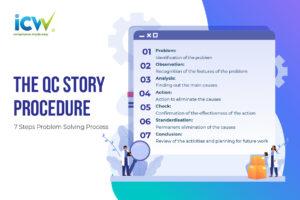
The QC Story Procedure is designed for problem-solving. A problem is defined in the QC Story as:
A problem is the undesirable result of a job.

- Show that the problem being handled is of much greater importance than any other problems.
- Show what the background of the problem is and what its cause has been so far.
- Express in concrete terms only the undesirable results of poor performance. Demonstrate the performance loss in the present situation and how much it should be improved.
- Set up a theme and a target, and sub-themes if necessary.
- Nominate a person to take charge of the task officially. When a team carries out the study, nominate the members and the leader.
- Present an estimated budget for the improvement.
- Make a schedule for the improvement.

2 Observation
Investigate the specific features of the problem from a wide range of different viewpoints.
- Investigate four points (time, place, type, and symptom) to discover the features of the problem.
- Then investigate from many different points of view to discover the variation in the results.
- Go to the site and collect the necessary information that cannot be put into a data form.

Find out what the main causes are.
- Write down a cause-and-effect diagram (a diagram that contains all elements seemingly related to the problem) to collect all knowledge concerning possible causes.
- Use the information obtained in the observation step and delete any elements that are not relevant; revise the cause-and-effect diagram using the remaining elements.
- Mark those elements in the latter diagram which seem to have a high possibility of being the main causes.
- From elements with a high possibility of being caused, devise a new plan to ascertain the effect those elements have on the problem by obtaining new data or carrying out experiments.
- Integrate all the information investigated and decide which are the main possible causes.
- If possible, intentionally reproduce the problem.

- A strict distinction must be made between actions taken to cure phenomena (immediate remedy) and activities brought to eliminate cause factors (preventing recurrence).
- Ensure the actions do not produce other problems (side effects). If they do, adopt other measures or devise remedies for the side effects.
- Devise several different proposals for action, examine the advantage and disadvantages of each and select those to which the people involved agree.

Make sure the problem is prevented from occurring again.
- In the same format (tables, graphs, charts), compare the data obtained on the problem (undesirable results in the theme) before and after the action has been taken.
- Convert the effects into monetary terms and compare the result with the target value.
- If there are any other effects, good or bad, list them.

6 Standardization
Eliminate the cause of the problem permanently.
- The five Ws and one H: who, when, where, what, why and how, for the improved job must be identified and used as a standard.
- Necessary preparation and communication regarding the standards should be carried out correctly.
- Education and training should be implemented.
- A responsibility system must be set up to check whether the standards are being observed.

7 Conclusion
Review the problem-solving procedure and plan future work
- Sum up the problems remaining.
- Plan what is to be done to solve those problems.
- Think about what has gone well and badly in the improvement activities.
Partners Zone

- QC Story — An overview
When it comes to quality control, continuous improvement plays a key role in industries striving for excellence. Here’s where the QC comes in.
This method, developed in Japan, has proven dramatically effective in boosting industrial processes and operations.
Let’s take a look at it in more detail.
What is QC Story?
At its core, QC Story —or Quality Control Story— is a systematic problem-solving approach that empowers organisations to identify, analyse, and rectify quality issues within their operations.
This structured problem-solving technique works by leveraging data analysis to drive quality improvements.
QC Story originated in the 1960s in Japan as part of the broader Total Quality Control (TQC) movement.
QC Story aims to address process inefficiencies by identifying their root causes and implementing corrective actions to eliminate or minimise them.
Why do we use QC Story?
For many reasons, one of them being that it promotes a culture of continuous improvement throughout the entire organisation.
QC Story brings a systematic approach to problem-solving, guiding teams to take action in a structured way. This means collaboration and cross-departmental participation go up, and wasting time and resources trying to figure out the next step goes down.
This method highlights the importance of data collection and analysis to inform the next steps. This helps your team make decisions based on real-time evidence and avoid guesswork. By using data, identifying patterns and correlations becomes easier and faster.
Because QC Story focuses on finding and addressing the root cause of the issue, organisations get permanent solutions to their problems. This proactive approach prevents recurring issues and reduces waste, enhancing product quality and customer satisfaction.
QC Story is mainly used to rectify and prevent process failures while enhancing decision-making. It’s typically used to:
- Resolve non-conformities and evaluate observations that do not align with set parameters
- Minimise variations that could potentially compromise the quality of your products
- Tackle problems at their source by implementing corrective and preventive actions
How many steps are in QC Story?
QC Story typically comprises eight key steps:

Identify the problem
The first step involves identifying the problem to fix. The issue should be clearly defined, specific, and measurable to facilitate effective problem-solving.
If there’s more than one problem, it’s essential to have a priority list to deal with each issue at the right time.
Observe the problem
In this step, take a cross-departmental approach to problem-solving and get as many relevant people involved as possible. This will give you different perspectives on the issue while fostering collaboration.
Analyse the cause
Before we go any further, it’s critical to note that you can classify your causes into three groups:
- Possible causes
- Probable causes
- Root causes
So, in this step, you collect relevant data to understand the cause of the problem. This data may include measurements, observations, customer feedback, or other relevant information.
Analyse your data using statistical tools and techniques to identify patterns, trends, and potential root causes of the problem. Some helpful tools are Pareto charts, scatter diagrams, and cause-and-effect diagrams.
Propose evidence-based action plans
Once you find the problems and what’s causing them, it’s time to sit down and come up with a strategic plan of action to fix these issues.
At this stage, you should define responsibilities, deadlines, and specific actions to solve the problem successfully.
Execute your plans
After planning comes the execution.
Make sure that responsibilities are clearly assigned and that everybody is properly trained to handle their duties.
Verify your results
Here’s where you do a quality control on your Quality Control Story.
Take your actions and measure them against the goals you defined in your plan of action.
If everything looks great, move ahead.
If you need to make adjustments, now is the time to do so.
Standardise your procedures
Once you know that your actions work, you need to develop standards to prevent the issue from happening again.
This process needs to be ongoing, as you’ll have to audit the measures in place regularly to make adjustments if needed.
Create a closing report
Everything you did to tackle this issue needs to be documented, labelled, and dated.
This report must include lessons learned, positive and negative, to inform your action plans in the future.
How to measure QC Story
There are many ways to check whether this approach worked or not.
Some of them are:
- The number of errors has gone down , meaning the issue has been dealt with successfully.
- Your KPIs are changing since you implemented the measures. If the problem you identified is causing a decline in production efficiency, when that production efficiency goes up is because your implementation of QC Story worked.
- The level of employee engagement with the problem-solving process.
- The cost-effectiveness derived from implementing your measures . This can come from reduced waste, minimised rework, and optimised processes
- Customer feedback
mlean ® & QC Story
QC Story is a robust methodology that enables organisations to tackle quality issues systematically, drive continuous improvement, and enhance industrial processes.
Embracing QC Story empowers organisations to create a culture of quality, efficiency, and customer satisfaction, propelling them toward operational excellence in today’s competitive landscape.
But even better than QC Story is our mlean® Production System (mPS).
We developed this software to help you identify, fix, and prevent issues in your factories, connecting your workers and boosting your profitability.
Our mPS features many problem-solving methodologies, so you’ll always have the right tool at the right time.
Because everything is centralised and digitalised, you won’t have to worry about losing critical data or having to integrate it with other systems.
mlean® Production System helps you through all your industrial processes, such as:
- Standard work
- Shop floor management
- Start of production
- Maintenance
- And many more
Our mPS isn’t just a tool. It’s a scalable business partner that connects your workers to your processes, improving your cost-effectiveness and letting you know what’s happening at all times.
Give us a try and see for yourself!
Book a free demo today

Alba Rodriguez
- Industry Trends (27)
- mlean news (21)
- Product (2)
- Standardization (4)
- Strategy (5)
Recent Post

The link between continuous improvement and worker satisfaction

Factory performance: how to level up your game

How delivery impacts your factory’s ability to be competitive
Connect with us
on social media
with any questions
Book a demo
Duis aute irure dolor in reprehenderit in voluptate.
- Privacy Overview
- Strictly Necessary Cookies
- 3rd Party Cookies
- Cookie Policy
This website uses cookies so that we can provide you with the best user experience possible. Cookie information is stored in your browser and performs functions such as recognising you when you return to our website and helping our team to understand which sections of the website you find most interesting and useful.
Strictly Necessary Cookie should be enabled at all times so that we can save your preferences for cookie settings.
This website uses Google Analytics to collect anonymous information such as the number of visitors to the site, and the most popular pages.
Keeping this cookie enabled helps us to improve our website.
Please enable Strictly Necessary Cookies first so that we can save your preferences!
More information about our Cookie Policy
- DAM – Daily Audit Management
- APS – Advanced Problem Solving
- TMM – Total Maintenance Management
- SAM – Small Activity Management
- PMB – Performance Management Board
- ESB – Enterprise Schedule Builder
- EPP – Enterprise Project Planner
- VCB – Visual communication board
- BDM – Business Document Management
- 5 Whys Analysis
- TPM – Total Productive Maintenance
- PDCA and DEMING CYCLE
- Work Standardization
- Lean production
QC STORY and PROBLEM SOLVING

QC Story is a tool of TQM (Total Quality Management) , which is intended to solve problems in a structured way . QC story is based on the principle of PDCA , where the nine steps can present the full story of the choice of the case to complete solutions.
QC Story tool is not among the most popular in the world, although in content and purpose, it is the same or identical to the more familiar A3 analysis . Usually, it is formalized on a sheet of paper or even on a billboard or poster. Larger formats, such as 2x2 meters, are popular especially in companies with well-developed visual management .
For a clear and visually displayed case in the form of the story , it allows for a better breakdown of the problem and resolution and especially understanding.
The disadvantage of such impressions is that there is relatively difficult to control information and the database. Therefore we developed a DIGITAL LEAN tool , which facilitates managing information and displaying them on each occasion, on any media, like a computer, or LCD screen.
The solution we named APS - Advanced Problem Solving and made it universal since it can be used in addition to the QC story and also replace other traditional tools such as A3, 8D report . Even more, with APS tool we can implement the projects of chronic losses elimination and other projects based on the PDCA, DMAIC …, more structured and efficient.
What is the purpose of the tools QC story?
Problem-solving is now crucial for any company that wants to be competitive. Instead of merely a corrective or fire campaign, we want to determine the root causes of why a problem occurred and found solutions. This means that we are focused on continuous improvement in all areas, from quality, safety, reliability, cost ...
QC story, however, is not merely a problem-solving tool, but also a communication tool . It's a way to present the problem in a clear and understandable manner to a wider range of employees. So all employees understand the work processes and the root causes of the caused problems. Gradually, in solving problems, all employees begin to include, including operators, which means for them the new challenges in the workplace and creating new higher value-added.
Related posts
How to find the root cause for major breakdown.
Failure-based root cause analysis is a method of problem-solving used for identifying the root causes of failure analysis for those employed in engineering and maintenance. TMM - Total Maintenance Management is an innovative computer tool for solving major breakdowns or...
DIFFERENT APPROACHES IN THE 5S IMPLEMENTATION
Method 5S has five steps, but there are several approaches to realise it. It is necessary to distinguish, that 5S is not only carrying the activities, related to tidiness and cleanliness, but it is a structured approach to ensure efficiency...
APS – Advanced Problem Solving
APS - Advanced Problem Solving is the computer tool, which is essentially based on solving the problem on the principle of PDCA, where we present the whole story in the nine steps, from the choice of the case, to complete...
Educational Materials

QC Story: what is it and how does it work?
This guide helps you to understand about the qc story (quality control story) for problem solving and its relationship with the pdca cycle..
Published on June 30, 2017
Updated on September 1, 2022
Focused Improvement – The QC Story
The basic procedure for solving any problem is to identify the problem, analyze its causes, put together a plan for solving it, and carry out that plan. The QC story (or Improvement Story) is a simple, practical way of doing this and thereby solving problems efficiently. It consists of the following steps:
- Step 1: Choose a topic
- Step 2: Assess the current situation and set targets
- Step 3: Draw up a schedule of activities
- Step 4: Identify the causes of the problem
- Step 5: Formulate and carry out a plan for eliminating those causes
- Step 6: Check the results
- Step 7: Ensure that the problem cannot recur (e.g. by standardising)
- Step 8: Decide on the next topic to tackle, and make a plan for doing so
Although the details of the steps may vary from one company to the next or from one textbook to the next, the basic QC Story remains the same and should be studied until it is well understood. Table “The QC Story and the QC Tools” outlines each of the steps of the QC Story and indicates which QC tool should be used at each step.
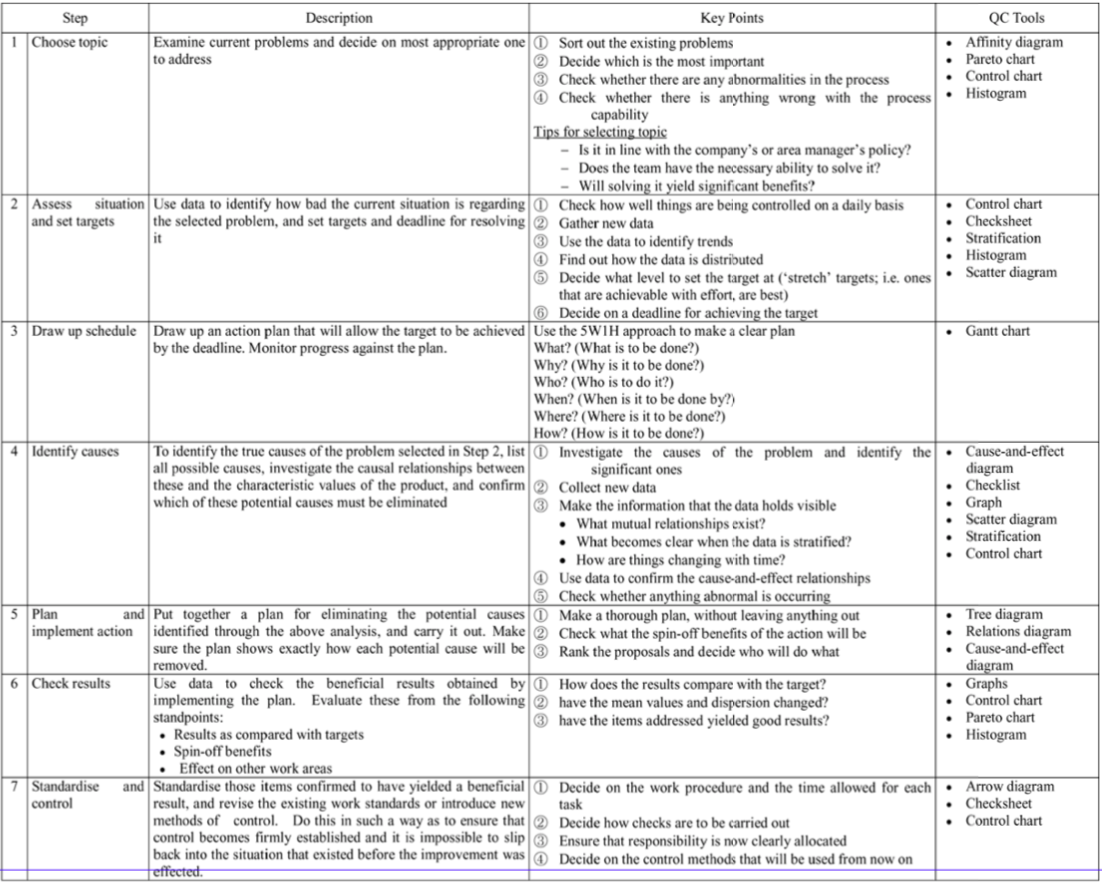
- More By sensei
- More In Focused Improvement

Unlock the Power of Continuous Learning with Udemy’s Frequent Sales

How to Ace Your Next Job Interview: Expert Insights and Strategies

Mastering the Trio: Project, Program & Portfolio Management

The Evolution of Performance Reviews: From Annual Appraisals to Continuous Feedback

Behaviors that kill employee motivation

Free Udemy Courses 100% Coupon

TPM Pillar Self Assessment
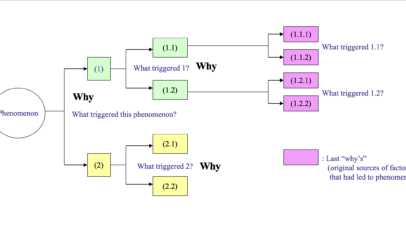
Focused Improvement. Why-why Analysis
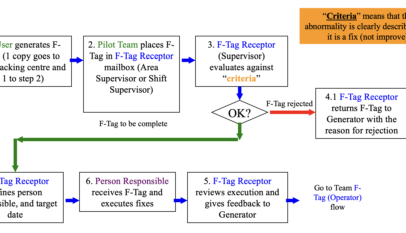
The 3 Tools of TPM

Focused Improvement – The Steps of P-M Analysis. Steps 5 – 8
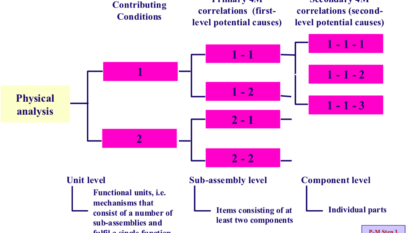
Focused Improvement – The Steps of P-M Analysis. Steps 1 – 4
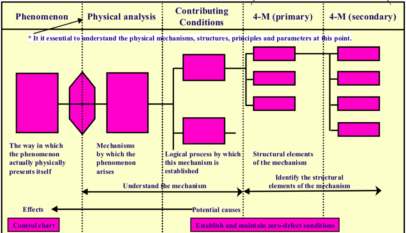
Focused Improvement – The Structure of P-M Analysis
Leave a reply cancel reply.
Your email address will not be published. Required fields are marked *
Most Popular

4M Analysis Process
The purpose of this procedure is to define the steps to do a 4M …

OPL – One Point Lesson Template – Free Download

PDCA – A Process Approach

5S Audit Checklist and Report

Why-Why Analysis
Blog Search

- Terms of Use
- Privacy Policy
- About Our Ads
- Memberships
Quality Circle (QC) explained

Quality Circle (QC): this article explains the concept of a Quality Circle (QC) in a practical way. Highlights of this article include: a definition of a QC, the history of quality circles and the conditions and steps to set up a QC. After reading it, you will understand the basics of this quality management and quality improvement tool, originating from the Japanese industry. Enjoy reading!
What is Quality Circle?
A Quality Circle (QC) is a participation management technique to manage and improve the quality of the entire organisation and to find solutions to management problems. The power of a QC comes from mutual trust between managers and employees, which leads to more mutual understanding.
The purpose of a QC is to build towards a good relationship with employees, so they will show more interest and devotion in the work they do. This will result in increased quality, productivity and cost reduction.

History of Quality circle
QC’s first appeared in Japan. It was Japanese professor Kaoru Ishikawa who first used the term quality circles and made it accessible in his 1985 manual ‘What is Total Quality Control? The Japanese Way’ . The underlying idea was to systematically include employees from all levels in the organisation-wide production of quality. Later, Edwards Deming introduced a similar work in his quality circle.
Many businesses in Europe and the United states also adopted working with quality circles, including Hewlett-Packard and Coleman . The latter business started with quality circles when the lifespan of a torch battery did not meet expectations. Quality Circle Objectives
The main objective of a QC is eventually help solve a problem that impacts the total performance of the organization. QC’s are primarily about identifying problems to then lead to suggestions for solutions of these problems.
Quality Circle and composition
Employees show more loyalty and devotion to their organisation when they are open to collaboratively define and solve problems concerning quality or performance . This is easiest when it concerns smaller teams of approximately 3 to 12 people.
In this, it is a requirement that they voluntarily participate in the QC and meet regularly. The main concept of a QC is based on mutual respect, in which there is no place for assumptions and suspicion. The small group is best led by a manager.
It is important that the participants in the QC have the correct knowledge and are trained beforehand by the so-called facilitators; experts in the area of personnel and employment relationships.
Quality circles offer employees the opportunity to use all their experience, knowledge and creativity to bring improvement into their activities.
They are able to convert challenging problems into opportunities with the solution they offer themselves. Employees are generally free to select subjects in the QC’s.
Some typical subjects that are extremely suitable for discussion in circles are improvements concerning health and safety at work, improvement concerning the workplace and concerning production processes and the product design.
What are the conditions to set-up a QC?
To truly do QC’s justice, it is important to meet several conditions. In the first place, the mood needs to be relaxed. People need to feel comfortable and be free to share their own opinion.
Every member of the QC also needs to get their turn. This is the only way for employees to feel involved and be interested, which will motivate them to contribute. There is also a need to determine a clear goal, so everyone knows what is expected of them.
People need to be open to each other’s point of view and listen to all opinions. If an action emerges, clear agreements must be made that are accepted by all employees.
Quality Circle steps
To contribute to a QC, it is recommended to first create a quality control group within the organisation, which is represented by managers that know production, quality control and process planning. This control group’s task is to follow the quality circle.
A facilitator will also need to be appointed, and the groups needs to be led by a supervisor, as well as a chair who is capable of getting all conversations in the circle to run smoothly. Apart from the responsibility to lead a quality circle, they need to give each employee the opportunity to participate in the discussion and motivate them to come up with creative ideas. The chair is in close contact with the facilitator.
The facilitator functions as a link between top management, the quality circle and its members and middle management. They coordinate training courses, so all employees know the ins and outs of working in a quality circle. Another task of the facilitator is to create support and get support from everyone involved with the quality circle.
Focus areas
QC’s can only function when there is an interest in letting go of hierarchy . Where managers set themselves up as leaders, a group of workers will not be motivated to participate in the circle.
Employees can also not be expected to participate in the meetings of the QC’s outside office hours or without payment. An organisation would do well to integrate this into work time.


It’s Your Turn
What do you think? Is the concept of a QC applicable in your personal or professional environment? Do you organize quality circle meetings? Do you recognize the practical explanation or do you have more suggestions? What are your success factors for good participation management?
Share your experience and knowledge in the comments box below.
More information
- Hill, S. (1991). Why quality circles failed but total quality management might succeed . British journal of industrial relations, 29(4), 541-568.
- Hutchins, D. (1985). Quality circles handbook . Pitman.
- Kaoru, I. (1985). What is Total Quality Control: the Japanese Way .
- Feigenbaum, A. V. (1956). Total quality-control . Harvard business review, 34(6), 93-101.
How to cite this article: Mulder, P. (2018). Quality Circle (QC) . Retrieved [insert date] from Toolshero: https://www.toolshero.com/quality-management/quality-circle/
Original publication date: 06/21/2018 | Last update: 11/08/2023
Add a link to this page on your website: <a href=”https://www.toolshero.com/quality-management/quality-circle/”>Toolshero: Quality Circle (QC)</a>
Did you find this article interesting?
Your rating is more than welcome or share this article via Social media!
Average rating 4 / 5. Vote count: 13
No votes so far! Be the first to rate this post.
We are sorry that this post was not useful for you!
Let us improve this post!
Tell us how we can improve this post?

Patty Mulder
Patty Mulder is an Dutch expert on Management Skills, Personal Effectiveness and Business Communication. She is also a Content writer, Business Coach and Company Trainer and lives in the Netherlands (Europe). Note: all her articles are written in Dutch and we translated her articles to English!
Related ARTICLES

Charles Kepner biography and books

Eight Dimensions of Quality by David Garvin

Agile Crystal Method explained

Philip Crosby biography, quotes and books

Zero Defects philosophy by Philip Crosby

Psychological Safety by Amy Edmondson
Also interesting.

Measurement System Analysis (MSA)

Just In Time: an Inventory Management Method

Gemba Kaizen explained: meaning and theory
Leave a reply cancel reply.
You must be logged in to post a comment.
BOOST YOUR SKILLS
Toolshero supports people worldwide ( 10+ million visitors from 100+ countries ) to empower themselves through an easily accessible and high-quality learning platform for personal and professional development.
By making access to scientific knowledge simple and affordable, self-development becomes attainable for everyone, including you! Join our learning platform and boost your skills with Toolshero.

POPULAR TOPICS
- Change Management
- Marketing Theories
- Problem Solving Theories
- Psychology Theories
ABOUT TOOLSHERO
- Free Toolshero e-book
- Memberships & Pricing

- All courses
Productivity
7 qc tools for quality improvement.
*Optional training delivery method for this course: Remote Online Training (ROT) or Face-to-Face (F2F) !
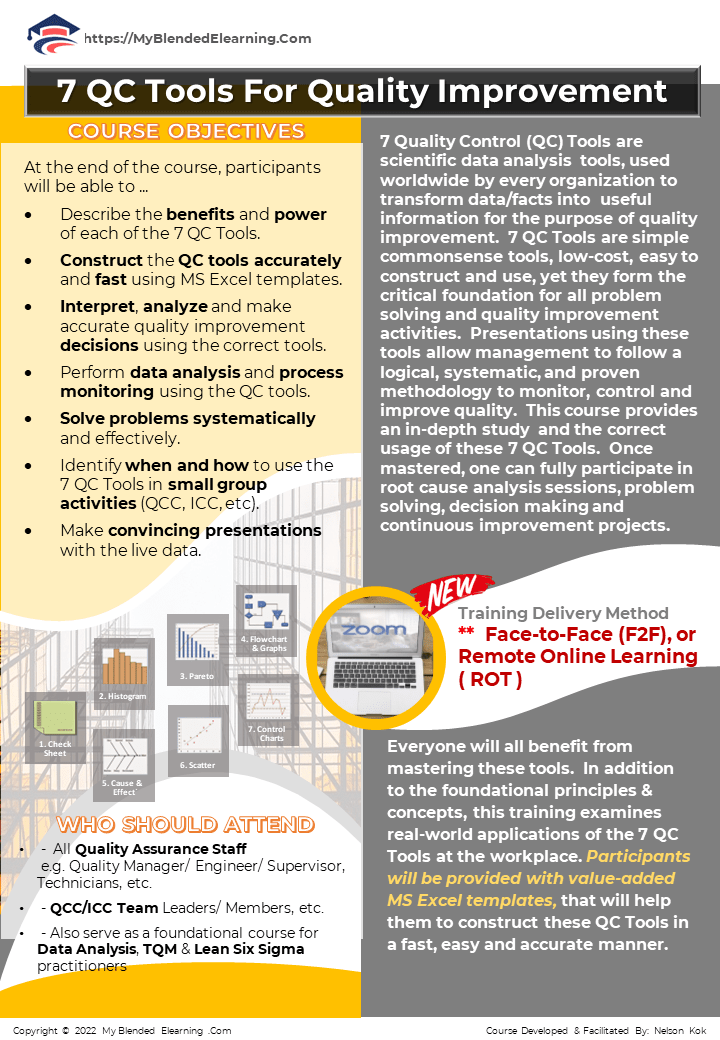
COURSE DESCRIPTION
7 QC Tools For Quality Improvement course provides an in-depth study of the 7 Basic QC (Quality Control) Tools. They are scientific management tools, used worldwide by almost every organizations to collect and analyze data/facts for the purpose of quality improvements. The 7 QC Tools are simple tools, low-cost and easy-to-use; but they are powerful tools that forms the critical foundation for all problem solving and quality improvement activities. Once mastered, these tools will serve as the solid foundation for individuals’ and team’s root cause analyses, problem solving sessions, and continuous improvement projects.
Manufacturing and service industry professionals, quality technicians and auditors, and industrial engineers will all benefit from understanding these tools. In addition to the foundational principles and concepts, this training examines practical real-world applications of the 7 QC Tools in the workplace. Participants will be provided with value-added MS Excel templates. These templates will help construct those QC Tools fast, easy and accurately.
This course is a MUST for all Quality Assurance staff such as Quality Engineers, Technicians, QC Leaders and also serve as a foundational course for Data Analysis & Lean Six Sigma practitioners.
CERTIFICATION
No certification.
Certificate of Achievement (for those who scored 80% and above for post-test) or Certificate of Attendance.
LEARNING OUTCOMES
At the end of the course, participants will be able to:
- Describe the benefits and power of each of the 7 QC Tools and its applications.
- Construct the QC tools accurately and fast using Microsoft Excel templates.
- Interpret , analyze and make accurate quality improvement decisions using the correct tools
- Perform data analysis and process monitoring using the QC tools
- Solve problems systematically and effectively.
- Experience the Quality Control Circle (QCC) team dynamics in solving problems.
- Make convincing presentations with the data collected from their workplace.
COURSE OUTLINE
Please see eBrochure above for more information.
To register, please Whatsapp : +60-19-502 2718 or email us at [email protected]
Course Features
- Skill level All level
- Language English
- Students 1632
- Assessments Yes
You May Like
Root cause analysis (rca).
Quality Control Circle (QCC) / Innovative & Creative Circle (ICC)

KAIZEN Strategies for Quality and Productivity Improvement
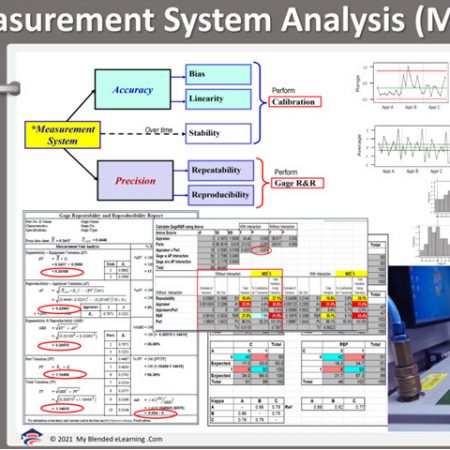
Measurement System Analysis (MSA)
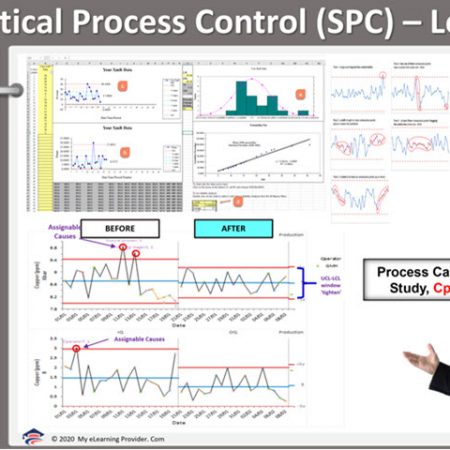
Statistical Process Control -Level 1 (SPC1)
Modal title.
Message modal

7 QC Tools: Your Ultimate Guide To Quality Improvement

Introduction to 7 QC tools
Quality management is an important aspect of any organization, and achieving it requires effective problem-solving strategies. In this regard, the 7 QC tools offer a comprehensive approach to problem-solving and quality improvement. These tools are designed to help organizations identify the root cause of problems, make data-driven decisions, and ultimately improve the quality of their products or services. In this post, we will explore the importance of the 7 QC tools, their history and evolution, how to select the right tool for quality control, and detailed explanations of each of the 7 QC tools.
Importance of 7 QC tools in quality management
The importance of 7 QC tools in quality management cannot be overstated. These tools help organizations to improve quality by providing a systematic approach to problem-solving. They enable organizations to analyze data, identify problem areas, and make data-driven decisions. By using these tools, organizations can reduce costs, increase productivity, and improve customer satisfaction. The 7 QC tools are widely used in various industries, including manufacturing, healthcare, and service sector. They are easy to use, cost-effective, and can be applied to various types of problems.
History and evolution of 7 QC tools
The history and evolution of the 7 QC tools can be traced back to the early 1920s when Dr. Walter A. Shewhart introduced the concept of statistical process control (SPC). Over time, additional techniques were added to the original seven, and the tools evolved to include Pareto charts, cause-and-effect diagrams, check sheets, histograms, scatter diagrams, and control charts. Today, the 7 QC tools are widely used in quality management and have become an integral part of Lean and Six Sigma methodologies.
How to select the right tool for quality control
Here are some points to consider when selecting the right tool for quality control:
- Identify the problem: Before selecting a tool, it is important to clearly identify the problem at hand. This will help determine which tool is best suited for the job.
- Understand the data: Understanding the data available is crucial for selecting the right tool. Some tools are better suited for qualitative data, while others work best with quantitative data.
- Determine the scope: Consider the scope of the problem and the level of detail required to solve it. Some tools are better suited for analyzing specific details, while others provide a more holistic view of the problem.
- Consider the complexity: Some problems are more complex than others, and require more sophisticated tools to solve. Consider the level of complexity and choose a tool that is appropriate for the problem at hand.
- Evaluate the strengths and limitations: Each tool has its own strengths and limitations. It is important to understand these before selecting a tool, so that you can choose one that is best suited for the problem at hand.
- Seek expert advice: If you are unsure which tool to use, seek advice from experts in the field. They can provide valuable insights and help you select the right tool for the job.
By considering these factors, you can select the right tool for quality control and ensure that your problem-solving efforts are effective and efficient.
7 QC Tools Explained
1. Pareto Chart
A Pareto chart is a graph that displays the relative frequency or size of problems in descending order of importance. It is a tool for identifying the most significant causes of a problem or the largest sources of variation in a process. The chart uses a vertical bar graph to show the frequency or size of each problem, with the bars arranged in order of decreasing importance. The chart also includes a cumulative percentage line that shows the cumulative percentage of problems accounted for by each cause. Pareto charts are useful for prioritizing problems and identifying the root causes that should be addressed to have the most significant impact on process improvement.
2. Cause-and-effect diagram
A cause-and-effect diagram, also known as a fishbone diagram or Ishikawa diagram, is a tool used to identify the root causes of a problem. It is a structured approach that helps to identify and categorize the possible causes of a problem, based on the various factors that could contribute to it. The diagram starts with a problem statement at the head of the diagram and uses a structured approach to identify the possible causes, grouping them into categories such as people, process, equipment, materials, and environment. Cause-and-effect diagrams are useful for identifying the root causes of a problem and for organizing and structuring the potential causes in a way that can be easily analyzed and addressed.
3. Check sheet
A check sheet is a tool used to collect data in a structured way. It is a simple form that is used to record data in a standardized format, making it easy to collect and analyze data across different processes or situations. Check sheets can be used to track defects or errors, record the frequency of events, or collect other types of data. They are useful for identifying patterns and trends in data, as well as for tracking progress and improvement over time.
4. Histogram
A histogram is a graph that shows the distribution of data. It is a visual representation of how frequently certain values occur within a set of data, using a series of vertical bars. The bars are grouped into categories or ranges of values, with the height of each bar representing the number of data points that fall within that category. Histograms are useful for identifying the shape of the distribution, including the mean and standard deviation, and for identifying outliers or unusual data points.
5. Scatter diagram
A scatter diagram also known as a scatter plot, is a graph that shows the relationship between two variables. It is a visual representation of how one variable changes in response to changes in the other variable. Each data point is plotted on the graph as a point, with one variable represented on the x-axis and the other variable represented on the y-axis. Scatter diagrams are useful for identifying correlations or patterns in data, and for identifying outliers or unusual data points. They are commonly used in quality control and process improvement to identify relationships between process variables and product quality or performance.
6. Control Charts
A control chart is a tool used to monitor and control a process over time. It is a graphical representation of data collected from a process, plotted against established control limits. The chart shows how the process is performing and alerts the user to any changes or variations that may occur. Control charts are useful for identifying trends, detecting shifts or changes in the process, and for identifying the sources of variation that may be causing problems. They can be used to monitor any process that produces data, from manufacturing to healthcare to financial services.
7. Flow Charts
A flow chart is a diagram that shows the steps in a process or system. It is a visual representation of the sequence of activities involved in a process, from start to finish. Flow charts are used to help understand a process, identify bottlenecks or inefficiencies, and to design or improve a process. The chart consists of boxes, symbols, and arrows that indicate the flow of the process. Boxes represent steps or actions in the process, while arrows represent the flow of materials or information between steps. Flow charts are useful for analyzing and improving any process, from simple to complex, and can be used in a variety of industries, including manufacturing, healthcare, and software development.
7 QC Tools: A Summary Table
These 7 QC tools are often used in combination with each other and with other quality management tools to improve quality and productivity, reduce costs and waste, and enhance customer satisfaction. The 7 QC Tools can be applied across various industries, including manufacturing, healthcare, finance, and service industries. These tools help to identify problems, analyze data, and improve processes, leading to better quality control and customer satisfaction. Knowing how and when to use each tool is essential to their effectiveness and achieving process improvement.
7 QC Tools Limitations:
While the 7 QC tools are widely used and effective for quality management, there are some limitations to their application. Here are some of the common limitations:
- Limited scope: The 7 QC tools are primarily focused on identifying and analyzing data related to quality issues and do not address other important aspects of quality management such as customer satisfaction, process improvement, and strategic planning.
- Lack of guidance: While the 7 QC tools provide a structured approach to data analysis, they do not provide guidance on how to implement solutions or make improvements based on the results.
- Data interpretation: The accuracy and usefulness of the data analyzed using the 7 QC tools depend on the quality and reliability of the data collected. Incorrect data or incomplete data can lead to incorrect conclusions and ineffective solutions.
- Limited application: The 7 QC tools are designed for use in manufacturing and industrial settings, and may not be as relevant or applicable in service industries or other non-manufacturing settings.
- Insufficient for complex problems: The 7 QC tools are useful for identifying and analyzing simple quality problems with a single cause or factor, but may be insufficient for more complex problems that have multiple causes and variables.
- Overreliance on data: The 7 QC tools rely heavily on data analysis and may overlook other important factors that contribute to quality, such as employee involvement, leadership, and culture.
Alternative Approach to 7QC Tools:
There are several other quality management tools and methodologies that organizations can use in addition to or instead of the 7 QC tools. Some of these alternatives include:
- Six Sigma: A data-driven approach to quality management that aims to minimize defects and variability in processes and products by using statistical methods and tools.
- Lean Manufacturing: A methodology focused on reducing waste and improving efficiency in manufacturing processes by eliminating non-value-added activities, streamlining production flows, and increasing responsiveness to customer demands.
- Root Cause Analysis (RCA): A problem-solving technique used to identify the underlying causes of a problem or failure, and develop solutions to prevent recurrence.
- Failure Mode and Effects Analysis (FMEA): A proactive risk management tool that helps identify and mitigate potential failures and defects in products or processes before they occur.
- Statistical Process Control (SPC): A method for monitoring and controlling a process by using statistical techniques to identify and correct deviations and abnormalities in the process.
- Kaizen: A continuous improvement philosophy that emphasizes small, incremental changes in processes and systems, and encourages employee involvement and empowerment.
These tools and methodologies can be used alone or in combination with each other, depending on the specific needs and goals of the organization.
In conclusion, the 7 QC tools offer a comprehensive approach to problem-solving and quality improvement. They are data-driven, cost-effective, and provide a systematic approach to quality management. By using these tools, organizations can reduce costs, increase productivity, and improve customer satisfaction. However, it is important to select the right tool for the problem at hand, and to understand the strengths and limitations of each tool. The 7 QC tools have a rich history and have become an integral part of Lean and Six Sigma methodologies, making them an essential tool for any organization that wants to improve the quality of its products or services.
References:
Goetsch, D. L., & Davis, S. B. (2014). Quality management for organizational excellence. Upper Saddle River, NJ: Pearson.
Ishikawa, K. (1985). What is Total Quality Control? The Japanese Way. Englewood Cliffs, NJ: Prentice Hall.
Batch vs. One Piece Flow Manufacturing: Which Is Right For Your Business?
Maximizing Quality And Efficiency: The Power Of Design For Six Sigma (DFSS)
Leave a Comment Cancel reply
Save my name, email, and website in this browser for the next time I comment.
Reach out to us
Our proven process equips individuals with proven method and skills to create positive change and improve efficiency while reducing errors
© 2024 leansixsigmamadeeasy.com

7 Step QC Story Workshop
Learning objectives:.
To help Process & Engineering Managers to appreciate the principles & concept of 7 step QC Story approach for problem solving and how to can be applied to different problems
Expected Outcomes:
- Understand the concept of QC story and steps involved and how it can be used to solve problems
- Learn the tools and techniques that are used as a part of QC story problem solving approach
- Step by step process applying QC Story approach for different scenarios
- Practical strategies to manage problem solving teams
Target Audience:
Engineering Leadership Team, Manufacturing Managers, Supply Chain Managers, Quality Engineers, Process Improvement Professionals
One day interactive workshop
Broad Curriculum:
Broad scope is include here:
- 7 step QC approach and its benefits
- Linkage to Lean principles, Policy, DWM and PDCA
- Step-by-step hands-on training on QC Story tools & techniques
- Problem statement
- Process Flow Diagram
- Cause & Effect Analysis
- Data & Graphical Analysis Tools
- 5Why analysis
- Decision Matrix
- Brainstorming
- Pilot Planning & Results
- Mistake Proofing
- Control Plan & link to DWM
- Standard Work
- Control Charts
- Recognizing Team Efforts
All the methods to be covered in the training will be Application, Analysis or Synthesis as per Bloom’s taxonomy.
Aimed at encouraging exploratory learning, in this this workshop a full-fledged case study will be provided that the team will workshop from start to finish covering all the aspects covered above followed by facilitated group discussions to understand the QC Story principles & tools.
To conduct QC Story workshop in Chennai, Bangalore, Mumbai, Delhi and across India and to know more about the curriculum & structure & customization to your needs, contact us .
Sign-up for collaborat newsletter
Where We Can Help
- Client Centricity & Value Creation
- Sales Transformation
- Experience Design
- Enterprise Agility
- Data & Analytics
- Quality & Productivity Improvement
How We Can Help
- Strategic Workshops
- Implementation & Co-creation
- Training & Mentoring
- Client Research
- Data based Insights
- [email protected]
- +91-9176615766
A book by David Hutchins

12 Steps Program to Quality Circles in an Organization
Quality circles (qc), a powerful tool for improving organizational processes and employee engagement, have gained popularity in recent years.
In today’s discussion, we delve into the crucial aspects of Quality Circles, focusing on the 12 indispensable steps that play a pivotal role in identifying the root cause of problems and implementing effective solutions with the aid of various Quality Control (QC) tools.
Who are Quality Circle?
Quality circles are small groups of employees who voluntarily come together to identify, analyze, and solve work-related problems. They play a vital role in enhancing product quality, productivity, and job satisfaction.
Unlock the secrets to creating highly effective self-managing workgroups with this must-read book! Discover proven strategies and insights that can transform your team’s productivity and success.
Understanding Quality Circles
Quality circles are collaborative groups consisting of employees who work together to identify and resolve issues related to their work processes. These circles promote open communication, teamwork, and problem-solving skills among employees. Explore the future of work with ‘ Self-Managing Workgroups .’ This book is your roadmap to building agile, self-directed teams that drive innovation and results
Benefits of Quality Circles
Before we dive into the steps, let’s understand why quality circles are valuable. Quality circles bring several important advantages that anyone involved in a business can appreciate:
- Boosted Employee Morale
Quality circles make employees feel more involved and important. When employees actively help find and fix problems in their work, they feel happier and more motivated. This positive atmosphere can improve the overall mood at work and make employees enjoy their jobs more.
- Better Product Quality
One of the main goals of quality circles is to make products or services better. By identifying and solving problems in how things are done, quality circles help create products that are of higher quality. This means customers are happier with what they get, and they’re more likely to keep coming back.
- Savings on Costs
Quality circles are like detectives for finding and stopping wasteful spending. They can uncover ways to save money by making things work more efficiently. When a business operates more efficiently, it doesn’t waste resources, which can save a lot of money in the long run.
- Happier Customers
When employees care about making a product or service better, it usually results in happier customers. Happy customers are more likely to stick around and recommend the business to others. This can lead to more business and success.
In a nutshell, quality circles have some pretty great benefits: happier employees, better products, cost savings, and satisfied customers. These advantages can make a big difference in any business.
The Twelve Steps of QC
Now, let’s explore the 12 steps that make up the Quality Circle framework , guiding organizations toward lasting improvements.
Step 1: Formation of Quality Circle Teams
Start by finding employees who are enthusiastic about joining quality circles. Look for people who are eager and committed to making improvements. It’s essential to have a diverse group that includes members from different departments and roles within the company.
Step 2: Define Objectives
Next, it’s crucial to define what your quality circle aims to achieve. These goals should match your company’s overall mission and vision. This way, everyone knows what they’re working toward and why.
Step 3: Training and Orientation
Before diving into problem-solving, make sure your quality circle members have the right skills and knowledge. Provide training sessions to help them become effective problem solvers. This training equips them with the tools they need.
Step 4: Identifying Work-related Problems
Encourage quality circle teams to identify work-related problems that hinder productivity, product quality, or employee satisfaction. Quality circle teams should focus on identifying issues in the workplace that cause problems. These could be things that slow down work, lower product quality, or make employees unhappy.
Step 5: Problem Analysis
Once problems are identified, it’s time to dig deeper. Team members should work together to figure out why these problems exist and brainstorm solutions.
Step 6: Generating Solutions
Brainstorm solutions as a team and select the most viable ones. Ensure that these solutions are practical and feasible. Together, the team should generate ideas for solving the problems. It’s important to choose solutions that are practical and can be put into action.
Step 7: Implementing Solutions
Once you’ve picked the best solutions, it’s time to make them happen. Start implementing these solutions and keep an eye on how well they work. If something isn’t working, be ready to adjust.
Step 8: Monitoring and Evaluation
Continuously watch how the changes you’ve made are affecting the issues you identified. Are things getting better? Are they staying the same or getting worse? Monitoring helps you stay on track.
Step 9: Reporting and Documentation
Keep detailed records of everything your quality circle does. This includes how you identified problems, the solutions you tried, and what worked. These records are valuable for future reference.
Step 10: Recognition and Rewards
It’s essential to appreciate the hard work of your quality circle teams. Recognize and reward their efforts and achievements. This motivates them to stay engaged and do their best.
Step 11: Sharing Success Stories
Spread the word about the successes your quality circle teams have achieved. Share stories and lessons learned across your organization. This can inspire other teams and departments to follow suit.
Step 12: Continuous Improvement
Lastly, never stop looking for ways to make your quality circle processes and goals better. Encourage a culture of continuous improvement, where everyone is committed to getting even better at what they do.
3 Steps to Implementing Quality Circles in Your Organization
To implement quality circles effectively:
Step 1: Gain Leadership Support
Start by securing the support and commitment of top management within your organization. Leadership endorsement is crucial for the success of quality circles. When leaders show enthusiasm for this approach, it sends a clear message that quality circles are valued and integral to the organization’s goals.
Step 2: Encourage Employee Participation
Promote voluntary participation among employees. Ensure that they feel empowered to voice their concerns and ideas without fear of repercussions. Create an environment where employees understand that their contributions are essential to the success of quality circles. Encourage diverse participation to bring in different perspectives.
Step 3: Establish Effective Communication
Establish clear and open lines of communication between quality circle teams and management. Effective communication is key to the success of quality circles. It allows for the exchange of ideas, sharing of progress, and quick resolution of any issues that may arise during the implementation process.
Quality circles are a valuable asset for organizations looking to enhance productivity, product quality, and employee satisfaction. By following these twelve steps and fostering a culture of continuous improvement, you can successfully implement quality circles in your organization.
Frequently Asked Questions (FAQs)
- What is the primary purpose of quality circles in an organization? Quality circles aim to identify, analyze, and solve work-related problems, leading to improved product quality, productivity, and employee satisfaction.
- How can I motivate employees to participate in quality circles? Encourage voluntary participation and create a supportive environment where employees feel their contributions are valued.
- Are there any real-life examples of organizations that have benefited from quality circles? Yes, you can find a detailed case study of a successful quality circle implementation at Example Company .
- What role does leadership play in the success of quality circles? Leadership support is crucial for the success of quality circles. Top management should endorse and actively participate in the program.
- How can quality circle presentations be made more effective? Quality circle presentations should include real data and examples to illustrate the impact and benefits of quality circle initiatives.
Quick Skill Quality (Training for Technician)
My dear friend, this website helps to better learning and understand about quality and improve the practical skill for those who is starting his career in QA department .
- Privacy policy
Tuesday, March 16, 2021
12 steps of quality circle | qsqtech.com.
12 STEPS OF QUALITY CIRCLE
- Identification of work related problems
- Selection of problem
- Define the problem
- Analyze the problem
- Identification of cause
- Finding out the root cause
- Data analysis
- Developing solution
- Foreseeing probable resistance
- Trial implementation
- Regular implementation
- Follow up & review
STEP-1 Identification of work related problem:
- 'A' Category Problem
- 'B' Category Problem
- 'C' Category Problem
'A' Category Problem:
'b' category problem:, 'c' category problem: , step-2 selection of problem , step-3 define the problem, step-4 analyse the problem.
- Number of times the problem occurred.
- Defect quantity
- Effect of the problem in detail.
Pareto chart:
Step-5 identification of causes , cause & effect diagram: .
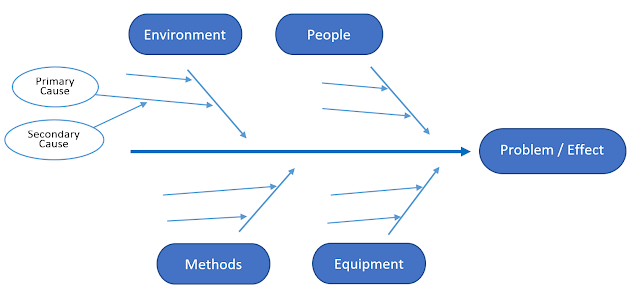
STEP-6 Finding out the root cause
Step-7 data analysis , step-8 developing solution , step-9 foreseeing probable resistance , step-10 trial implementation & check performance , step-11 regular implementation , step-12 follow up & review .
- Do you know history of Quality?
- How do you know about 3M waste?
- Do you know about biography of W. Edward Deming?
- How do you know about modern development of Quality?
No comments:
Post a Comment
Clamping force | How to calculate the clamping force in injection molding machine | Qsqtech.com
CLAMPING FORCE: Clamping force is an engineering term used in mechanical and manufacturing processes. The meaning of clamping force is to ...


Students’ Quality Circles pp 35–55 Cite as
What Are the Major Elements of Students’ Quality Circles?
- Dinesh P. Chapagain 2
- First Online: 14 July 2022
59 Accesses
There are four major elements which governs the activities of Students’ Quality Circles (SQCs). They are SQC principles, SQC approach, SQC problems, and SQC problem solving process. Teachers and students involved in SQC activities need to understand and follow these four important elements to operate SQC in a right direction to fulfill the purpose of developing pro-social personality of students making them good and smart. SQC activity enjoyed by students for their pro-social development is based on seven broad principles which represent the SQC movement’s fundamental beliefs. SQC works with a personality focused four-prong SQC approach to solve their common problem. Students at SQC team selects only those problems which should be self-identifiable and solvable as well as quantifiable, measurable and presentable, too. SQC team basically identify, analyze, and solve problems. While solving a problem, SQC uses the seven steps of scientific and systematic problem solving process. The SQC process consists of selecting topic, setting target, planning activities, analyzing causes, implementing countermeasures, checking results, and standardizing controls. These seven steps are further divided into twenty-three elementary steps.
- SQC principles
- SQC approach
- SQC problems
- SQC process
The difference between what we do and what we are capable of doing would suffice to solve most of the world’s problem . Mohandas Karam Chand Gandhi, Father of Nation, India
This is a preview of subscription content, log in via an institution .
Buying options
- Available as PDF
- Read on any device
- Instant download
- Own it forever
- Available as EPUB and PDF
- Compact, lightweight edition
- Dispatched in 3 to 5 business days
- Free shipping worldwide - see info
- Durable hardcover edition
Tax calculation will be finalised at checkout
Purchases are for personal use only
Author information
Authors and affiliations.
Kathmandu University, Kathmandu, Nepal
Professor Dinesh P. Chapagain
You can also search for this author in PubMed Google Scholar
Corresponding author
Correspondence to Dinesh P. Chapagain .
Rights and permissions
Reprints and permissions
Copyright information
© 2022 The Author(s), under exclusive license to Springer Nature Singapore Pte Ltd.
About this chapter
Cite this chapter.
Chapagain, D.P. (2022). What Are the Major Elements of Students’ Quality Circles?. In: Students’ Quality Circles. Springer, Singapore. https://doi.org/10.1007/978-981-19-1080-7_3
Download citation
DOI : https://doi.org/10.1007/978-981-19-1080-7_3
Published : 14 July 2022
Publisher Name : Springer, Singapore
Print ISBN : 978-981-19-1079-1
Online ISBN : 978-981-19-1080-7
eBook Packages : Education Education (R0)
Share this chapter
Anyone you share the following link with will be able to read this content:
Sorry, a shareable link is not currently available for this article.
Provided by the Springer Nature SharedIt content-sharing initiative
- Publish with us
Policies and ethics
- Find a journal
- Track your research
- SUGGESTED TOPICS
- The Magazine
- Newsletters
- Managing Yourself
- Managing Teams
- Work-life Balance
- The Big Idea
- Data & Visuals
- Reading Lists
- Case Selections
- HBR Learning
- Topic Feeds
- Account Settings
- Email Preferences
Share Podcast

Do You Understand the Problem You’re Trying to Solve?
To solve tough problems at work, first ask these questions.
- Apple Podcasts
- Google Podcasts
Problem solving skills are invaluable in any job. But all too often, we jump to find solutions to a problem without taking time to really understand the dilemma we face, according to Thomas Wedell-Wedellsborg , an expert in innovation and the author of the book, What’s Your Problem?: To Solve Your Toughest Problems, Change the Problems You Solve .
In this episode, you’ll learn how to reframe tough problems by asking questions that reveal all the factors and assumptions that contribute to the situation. You’ll also learn why searching for just one root cause can be misleading.
Key episode topics include: leadership, decision making and problem solving, power and influence, business management.
HBR On Leadership curates the best case studies and conversations with the world’s top business and management experts, to help you unlock the best in those around you. New episodes every week.
- Listen to the original HBR IdeaCast episode: The Secret to Better Problem Solving (2016)
- Find more episodes of HBR IdeaCast
- Discover 100 years of Harvard Business Review articles, case studies, podcasts, and more at HBR.org .
HANNAH BATES: Welcome to HBR on Leadership , case studies and conversations with the world’s top business and management experts, hand-selected to help you unlock the best in those around you.
Problem solving skills are invaluable in any job. But even the most experienced among us can fall into the trap of solving the wrong problem.
Thomas Wedell-Wedellsborg says that all too often, we jump to find solutions to a problem – without taking time to really understand what we’re facing.
He’s an expert in innovation, and he’s the author of the book, What’s Your Problem?: To Solve Your Toughest Problems, Change the Problems You Solve .
In this episode, you’ll learn how to reframe tough problems, by asking questions that reveal all the factors and assumptions that contribute to the situation. You’ll also learn why searching for one root cause can be misleading. And you’ll learn how to use experimentation and rapid prototyping as problem-solving tools.
This episode originally aired on HBR IdeaCast in December 2016. Here it is.
SARAH GREEN CARMICHAEL: Welcome to the HBR IdeaCast from Harvard Business Review. I’m Sarah Green Carmichael.
Problem solving is popular. People put it on their resumes. Managers believe they excel at it. Companies count it as a key proficiency. We solve customers’ problems.
The problem is we often solve the wrong problems. Albert Einstein and Peter Drucker alike have discussed the difficulty of effective diagnosis. There are great frameworks for getting teams to attack true problems, but they’re often hard to do daily and on the fly. That’s where our guest comes in.
Thomas Wedell-Wedellsborg is a consultant who helps companies and managers reframe their problems so they can come up with an effective solution faster. He asks the question “Are You Solving The Right Problems?” in the January-February 2017 issue of Harvard Business Review. Thomas, thank you so much for coming on the HBR IdeaCast .
THOMAS WEDELL-WEDELLSBORG: Thanks for inviting me.
SARAH GREEN CARMICHAEL: So, I thought maybe we could start by talking about the problem of talking about problem reframing. What is that exactly?
THOMAS WEDELL-WEDELLSBORG: Basically, when people face a problem, they tend to jump into solution mode to rapidly, and very often that means that they don’t really understand, necessarily, the problem they’re trying to solve. And so, reframing is really a– at heart, it’s a method that helps you avoid that by taking a second to go in and ask two questions, basically saying, first of all, wait. What is the problem we’re trying to solve? And then crucially asking, is there a different way to think about what the problem actually is?
SARAH GREEN CARMICHAEL: So, I feel like so often when this comes up in meetings, you know, someone says that, and maybe they throw out the Einstein quote about you spend an hour of problem solving, you spend 55 minutes to find the problem. And then everyone else in the room kind of gets irritated. So, maybe just give us an example of maybe how this would work in practice in a way that would not, sort of, set people’s teeth on edge, like oh, here Sarah goes again, reframing the whole problem instead of just solving it.
THOMAS WEDELL-WEDELLSBORG: I mean, you’re bringing up something that’s, I think is crucial, which is to create legitimacy for the method. So, one of the reasons why I put out the article is to give people a tool to say actually, this thing is still important, and we need to do it. But I think the really critical thing in order to make this work in a meeting is actually to learn how to do it fast, because if you have the idea that you need to spend 30 minutes in a meeting delving deeply into the problem, I mean, that’s going to be uphill for most problems. So, the critical thing here is really to try to make it a practice you can implement very, very rapidly.
There’s an example that I would suggest memorizing. This is the example that I use to explain very rapidly what it is. And it’s basically, I call it the slow elevator problem. You imagine that you are the owner of an office building, and that your tenants are complaining that the elevator’s slow.
Now, if you take that problem framing for granted, you’re going to start thinking creatively around how do we make the elevator faster. Do we install a new motor? Do we have to buy a new lift somewhere?
The thing is, though, if you ask people who actually work with facilities management, well, they’re going to have a different solution for you, which is put up a mirror next to the elevator. That’s what happens is, of course, that people go oh, I’m busy. I’m busy. I’m– oh, a mirror. Oh, that’s beautiful.
And then they forget time. What’s interesting about that example is that the idea with a mirror is actually a solution to a different problem than the one you first proposed. And so, the whole idea here is once you get good at using reframing, you can quickly identify other aspects of the problem that might be much better to try to solve than the original one you found. It’s not necessarily that the first one is wrong. It’s just that there might be better problems out there to attack that we can, means we can do things much faster, cheaper, or better.
SARAH GREEN CARMICHAEL: So, in that example, I can understand how A, it’s probably expensive to make the elevator faster, so it’s much cheaper just to put up a mirror. And B, maybe the real problem people are actually feeling, even though they’re not articulating it right, is like, I hate waiting for the elevator. But if you let them sort of fix their hair or check their teeth, they’re suddenly distracted and don’t notice.
But if you have, this is sort of a pedestrian example, but say you have a roommate or a spouse who doesn’t clean up the kitchen. Facing that problem and not having your elegant solution already there to highlight the contrast between the perceived problem and the real problem, how would you take a problem like that and attack it using this method so that you can see what some of the other options might be?
THOMAS WEDELL-WEDELLSBORG: Right. So, I mean, let’s say it’s you who have that problem. I would go in and say, first of all, what would you say the problem is? Like, if you were to describe your view of the problem, what would that be?
SARAH GREEN CARMICHAEL: I hate cleaning the kitchen, and I want someone else to clean it up.
THOMAS WEDELL-WEDELLSBORG: OK. So, my first observation, you know, that somebody else might not necessarily be your spouse. So, already there, there’s an inbuilt assumption in your question around oh, it has to be my husband who does the cleaning. So, it might actually be worth, already there to say, is that really the only problem you have? That you hate cleaning the kitchen, and you want to avoid it? Or might there be something around, as well, getting a better relationship in terms of how you solve problems in general or establishing a better way to handle small problems when dealing with your spouse?
SARAH GREEN CARMICHAEL: Or maybe, now that I’m thinking that, maybe the problem is that you just can’t find the stuff in the kitchen when you need to find it.
THOMAS WEDELL-WEDELLSBORG: Right, and so that’s an example of a reframing, that actually why is it a problem that the kitchen is not clean? Is it only because you hate the act of cleaning, or does it actually mean that it just takes you a lot longer and gets a lot messier to actually use the kitchen, which is a different problem. The way you describe this problem now, is there anything that’s missing from that description?
SARAH GREEN CARMICHAEL: That is a really good question.
THOMAS WEDELL-WEDELLSBORG: Other, basically asking other factors that we are not talking about right now, and I say those because people tend to, when given a problem, they tend to delve deeper into the detail. What often is missing is actually an element outside of the initial description of the problem that might be really relevant to what’s going on. Like, why does the kitchen get messy in the first place? Is it something about the way you use it or your cooking habits? Is it because the neighbor’s kids, kind of, use it all the time?
There might, very often, there might be issues that you’re not really thinking about when you first describe the problem that actually has a big effect on it.
SARAH GREEN CARMICHAEL: I think at this point it would be helpful to maybe get another business example, and I’m wondering if you could tell us the story of the dog adoption problem.
THOMAS WEDELL-WEDELLSBORG: Yeah. This is a big problem in the US. If you work in the shelter industry, basically because dogs are so popular, more than 3 million dogs every year enter a shelter, and currently only about half of those actually find a new home and get adopted. And so, this is a problem that has persisted. It’s been, like, a structural problem for decades in this space. In the last three years, where people found new ways to address it.
So a woman called Lori Weise who runs a rescue organization in South LA, and she actually went in and challenged the very idea of what we were trying to do. She said, no, no. The problem we’re trying to solve is not about how to get more people to adopt dogs. It is about keeping the dogs with their first family so they never enter the shelter system in the first place.
In 2013, she started what’s called a Shelter Intervention Program that basically works like this. If a family comes and wants to hand over their dog, these are called owner surrenders. It’s about 30% of all dogs that come into a shelter. All they would do is go up and ask, if you could, would you like to keep your animal? And if they said yes, they would try to fix whatever helped them fix the problem, but that made them turn over this.
And sometimes that might be that they moved into a new building. The landlord required a deposit, and they simply didn’t have the money to put down a deposit. Or the dog might need a $10 rabies shot, but they didn’t know how to get access to a vet.
And so, by instigating that program, just in the first year, she took her, basically the amount of dollars they spent per animal they helped went from something like $85 down to around $60. Just an immediate impact, and her program now is being rolled out, is being supported by the ASPCA, which is one of the big animal welfare stations, and it’s being rolled out to various other places.
And I think what really struck me with that example was this was not dependent on having the internet. This was not, oh, we needed to have everybody mobile before we could come up with this. This, conceivably, we could have done 20 years ago. Only, it only happened when somebody, like in this case Lori, went in and actually rethought what the problem they were trying to solve was in the first place.
SARAH GREEN CARMICHAEL: So, what I also think is so interesting about that example is that when you talk about it, it doesn’t sound like the kind of thing that would have been thought of through other kinds of problem solving methods. There wasn’t necessarily an After Action Review or a 5 Whys exercise or a Six Sigma type intervention. I don’t want to throw those other methods under the bus, but how can you get such powerful results with such a very simple way of thinking about something?
THOMAS WEDELL-WEDELLSBORG: That was something that struck me as well. This, in a way, reframing and the idea of the problem diagnosis is important is something we’ve known for a long, long time. And we’ve actually have built some tools to help out. If you worked with us professionally, you are familiar with, like, Six Sigma, TRIZ, and so on. You mentioned 5 Whys. A root cause analysis is another one that a lot of people are familiar with.
Those are our good tools, and they’re definitely better than nothing. But what I notice when I work with the companies applying those was those tools tend to make you dig deeper into the first understanding of the problem we have. If it’s the elevator example, people start asking, well, is that the cable strength, or is the capacity of the elevator? That they kind of get caught by the details.
That, in a way, is a bad way to work on problems because it really assumes that there’s like a, you can almost hear it, a root cause. That you have to dig down and find the one true problem, and everything else was just symptoms. That’s a bad way to think about problems because problems tend to be multicausal.
There tend to be lots of causes or levers you can potentially press to address a problem. And if you think there’s only one, if that’s the right problem, that’s actually a dangerous way. And so I think that’s why, that this is a method I’ve worked with over the last five years, trying to basically refine how to make people better at this, and the key tends to be this thing about shifting out and saying, is there a totally different way of thinking about the problem versus getting too caught up in the mechanistic details of what happens.
SARAH GREEN CARMICHAEL: What about experimentation? Because that’s another method that’s become really popular with the rise of Lean Startup and lots of other innovation methodologies. Why wouldn’t it have worked to, say, experiment with many different types of fixing the dog adoption problem, and then just pick the one that works the best?
THOMAS WEDELL-WEDELLSBORG: You could say in the dog space, that’s what’s been going on. I mean, there is, in this industry and a lot of, it’s largely volunteer driven. People have experimented, and they found different ways of trying to cope. And that has definitely made the problem better. So, I wouldn’t say that experimentation is bad, quite the contrary. Rapid prototyping, quickly putting something out into the world and learning from it, that’s a fantastic way to learn more and to move forward.
My point is, though, that I feel we’ve come to rely too much on that. There’s like, if you look at the start up space, the wisdom is now just to put something quickly into the market, and then if it doesn’t work, pivot and just do more stuff. What reframing really is, I think of it as the cognitive counterpoint to prototyping. So, this is really a way of seeing very quickly, like not just working on the solution, but also working on our understanding of the problem and trying to see is there a different way to think about that.
If you only stick with experimentation, again, you tend to sometimes stay too much in the same space trying minute variations of something instead of taking a step back and saying, wait a minute. What is this telling us about what the real issue is?
SARAH GREEN CARMICHAEL: So, to go back to something that we touched on earlier, when we were talking about the completely hypothetical example of a spouse who does not clean the kitchen–
THOMAS WEDELL-WEDELLSBORG: Completely, completely hypothetical.
SARAH GREEN CARMICHAEL: Yes. For the record, my husband is a great kitchen cleaner.
You started asking me some questions that I could see immediately were helping me rethink that problem. Is that kind of the key, just having a checklist of questions to ask yourself? How do you really start to put this into practice?
THOMAS WEDELL-WEDELLSBORG: I think there are two steps in that. The first one is just to make yourself better at the method. Yes, you should kind of work with a checklist. In the article, I kind of outlined seven practices that you can use to do this.
But importantly, I would say you have to consider that as, basically, a set of training wheels. I think there’s a big, big danger in getting caught in a checklist. This is something I work with.
My co-author Paddy Miller, it’s one of his insights. That if you start giving people a checklist for things like this, they start following it. And that’s actually a problem, because what you really want them to do is start challenging their thinking.
So the way to handle this is to get some practice using it. Do use the checklist initially, but then try to step away from it and try to see if you can organically make– it’s almost a habit of mind. When you run into a colleague in the hallway and she has a problem and you have five minutes, like, delving in and just starting asking some of those questions and using your intuition to say, wait, how is she talking about this problem? And is there a question or two I can ask her about the problem that can help her rethink it?
SARAH GREEN CARMICHAEL: Well, that is also just a very different approach, because I think in that situation, most of us can’t go 30 seconds without jumping in and offering solutions.
THOMAS WEDELL-WEDELLSBORG: Very true. The drive toward solutions is very strong. And to be clear, I mean, there’s nothing wrong with that if the solutions work. So, many problems are just solved by oh, you know, oh, here’s the way to do that. Great.
But this is really a powerful method for those problems where either it’s something we’ve been banging our heads against tons of times without making progress, or when you need to come up with a really creative solution. When you’re facing a competitor with a much bigger budget, and you know, if you solve the same problem later, you’re not going to win. So, that basic idea of taking that approach to problems can often help you move forward in a different way than just like, oh, I have a solution.
I would say there’s also, there’s some interesting psychological stuff going on, right? Where you may have tried this, but if somebody tries to serve up a solution to a problem I have, I’m often resistant towards them. Kind if like, no, no, no, no, no, no. That solution is not going to work in my world. Whereas if you get them to discuss and analyze what the problem really is, you might actually dig something up.
Let’s go back to the kitchen example. One powerful question is just to say, what’s your own part in creating this problem? It’s very often, like, people, they describe problems as if it’s something that’s inflicted upon them from the external world, and they are innocent bystanders in that.
SARAH GREEN CARMICHAEL: Right, or crazy customers with unreasonable demands.
THOMAS WEDELL-WEDELLSBORG: Exactly, right. I don’t think I’ve ever met an agency or consultancy that didn’t, like, gossip about their customers. Oh, my god, they’re horrible. That, you know, classic thing, why don’t they want to take more risk? Well, risk is bad.
It’s their business that’s on the line, not the consultancy’s, right? So, absolutely, that’s one of the things when you step into a different mindset and kind of, wait. Oh yeah, maybe I actually am part of creating this problem in a sense, as well. That tends to open some new doors for you to move forward, in a way, with stuff that you may have been struggling with for years.
SARAH GREEN CARMICHAEL: So, we’ve surfaced a couple of questions that are useful. I’m curious to know, what are some of the other questions that you find yourself asking in these situations, given that you have made this sort of mental habit that you do? What are the questions that people seem to find really useful?
THOMAS WEDELL-WEDELLSBORG: One easy one is just to ask if there are any positive exceptions to the problem. So, was there day where your kitchen was actually spotlessly clean? And then asking, what was different about that day? Like, what happened there that didn’t happen the other days? That can very often point people towards a factor that they hadn’t considered previously.
SARAH GREEN CARMICHAEL: We got take-out.
THOMAS WEDELL-WEDELLSBORG: S,o that is your solution. Take-out from [INAUDIBLE]. That might have other problems.
Another good question, and this is a little bit more high level. It’s actually more making an observation about labeling how that person thinks about the problem. And what I mean with that is, we have problem categories in our head. So, if I say, let’s say that you describe a problem to me and say, well, we have a really great product and are, it’s much better than our previous product, but people aren’t buying it. I think we need to put more marketing dollars into this.
Now you can go in and say, that’s interesting. This sounds like you’re thinking of this as a communications problem. Is there a different way of thinking about that? Because you can almost tell how, when the second you say communications, there are some ideas about how do you solve a communications problem. Typically with more communication.
And what you might do is go in and suggest, well, have you considered that it might be, say, an incentive problem? Are there incentives on behalf of the purchasing manager at your clients that are obstructing you? Might there be incentive issues with your own sales force that makes them want to sell the old product instead of the new one?
So literally, just identifying what type of problem does this person think about, and is there different potential way of thinking about it? Might it be an emotional problem, a timing problem, an expectations management problem? Thinking about what label of what type of problem that person is kind of thinking as it of.
SARAH GREEN CARMICHAEL: That’s really interesting, too, because I think so many of us get requests for advice that we’re really not qualified to give. So, maybe the next time that happens, instead of muddying my way through, I will just ask some of those questions that we talked about instead.
THOMAS WEDELL-WEDELLSBORG: That sounds like a good idea.
SARAH GREEN CARMICHAEL: So, Thomas, this has really helped me reframe the way I think about a couple of problems in my own life, and I’m just wondering. I know you do this professionally, but is there a problem in your life that thinking this way has helped you solve?
THOMAS WEDELL-WEDELLSBORG: I’ve, of course, I’ve been swallowing my own medicine on this, too, and I think I have, well, maybe two different examples, and in one case somebody else did the reframing for me. But in one case, when I was younger, I often kind of struggled a little bit. I mean, this is my teenage years, kind of hanging out with my parents. I thought they were pretty annoying people. That’s not really fair, because they’re quite wonderful, but that’s what life is when you’re a teenager.
And one of the things that struck me, suddenly, and this was kind of the positive exception was, there was actually an evening where we really had a good time, and there wasn’t a conflict. And the core thing was, I wasn’t just seeing them in their old house where I grew up. It was, actually, we were at a restaurant. And it suddenly struck me that so much of the sometimes, kind of, a little bit, you love them but they’re annoying kind of dynamic, is tied to the place, is tied to the setting you are in.
And of course, if– you know, I live abroad now, if I visit my parents and I stay in my old bedroom, you know, my mother comes in and wants to wake me up in the morning. Stuff like that, right? And it just struck me so, so clearly that it’s– when I change this setting, if I go out and have dinner with them at a different place, that the dynamic, just that dynamic disappears.
SARAH GREEN CARMICHAEL: Well, Thomas, this has been really, really helpful. Thank you for talking with me today.
THOMAS WEDELL-WEDELLSBORG: Thank you, Sarah.
HANNAH BATES: That was Thomas Wedell-Wedellsborg in conversation with Sarah Green Carmichael on the HBR IdeaCast. He’s an expert in problem solving and innovation, and he’s the author of the book, What’s Your Problem?: To Solve Your Toughest Problems, Change the Problems You Solve .
We’ll be back next Wednesday with another hand-picked conversation about leadership from the Harvard Business Review. If you found this episode helpful, share it with your friends and colleagues, and follow our show on Apple Podcasts, Spotify, or wherever you get your podcasts. While you’re there, be sure to leave us a review.
We’re a production of Harvard Business Review. If you want more podcasts, articles, case studies, books, and videos like this, find it all at HBR dot org.
This episode was produced by Anne Saini, and me, Hannah Bates. Ian Fox is our editor. Music by Coma Media. Special thanks to Maureen Hoch, Adi Ignatius, Karen Player, Ramsey Khabbaz, Nicole Smith, Anne Bartholomew, and you – our listener.
See you next week.
- Subscribe On:
Latest in this series
This article is about leadership.
- Decision making and problem solving
- Power and influence
- Business management
Partner Center
Tell Us About Your Problem-Solving Administrative Professional
For Administrative Professional Day, share your stories of a staff assistant, administrative assistant or executive assistant who makes a difference

Across Duke, roughly 1,000 administrative professionals in schools and departments help their units function smoothly.
And when things get busy, plans change quickly, or problems arise, these colleagues often find themselves in the middle of the solution.
In advance of National Administrative Professionals Day on April 24, we want to hear how Duke’s staff assistants, administrative assistants or executive assistants use their creativity, resourcefulness and problem-solving skills to help teams navigate the day to day.
Send a note and photo (if you have a picture) by 12 p.m. on April 12, to hr.duke.edu/sendnews . We’ll be in touch to chat more with you.
Send story ideas, shout-outs and photographs through our story idea form or write [email protected] .
Follow Working@Duke on X (Twitter) , Facebook, and Instagra m .

IMAGES
VIDEO
COMMENTS
Here in this post, you will find the complete 7 steps of the QC story. As a quality engineer, you will be working on problem-solving scenarios in the organization. And the concept of QC story is the same to solve problems using the step-by-step approach to solve the problem by assigning the project and completion.
The QC Story Procedure is designed for problem-solving. A problem is defined in the QC Story as: A problem is the undesirable result of a job. 1 Problem. Activities. ... Use the information obtained in the observation step and delete any elements that are not relevant; revise the cause-and-effect diagram using the remaining elements. ...
QC Story typically comprises eight key steps: Identify the problem. The first step involves identifying the problem to fix. The issue should be clearly defined, specific, and measurable to facilitate effective problem-solving. If there's more than one problem, it's essential to have a priority list to deal with each issue at the right time.
Finding a suitable solution for issues can be accomplished by following the basic four-step problem-solving process and methodology outlined below. Step. Characteristics. 1. Define the problem. Differentiate fact from opinion. Specify underlying causes. Consult each faction involved for information. State the problem specifically.
The QC Story is the name for a specific way of documenting and communicating the results of Quality Circles activities. Each QC Story shows how the circle members addressed a specific problem. Those of us familiar with other problem-solving steps such as A3 thinking, Toyota Kata, DMAIC and 8D problem solving will no doubt see the similarities.
The QC Story is an integral tool in Total Quality Management (TQM) aimed at addressing problems in a structured manner. It is based on the PDCA (Plan-Do-Check-Act) principle and involves presenting a problem-solving story in nine steps, from case selection to achieving a thorough solution. While not as widely recognized as other methodologies, the content and purpose of QC Story are equivalent ...
QC STORY and PROBLEM SOLVING. QC Story is a tool of TQM (Total Quality Management), which is intended to solve problems in a structured way. QC story is based on the principle of PDCA, where the nine steps can present the full story of the choice of the case to complete solutions. QC Story tool is not among the most popular in the world ...
Lean Six Sigma is a methodology that seeks to increase the profitability of companies through the improvement of their processes. Thinking about you and your career, we, at Think Lean Six Sigma, created a FREE Yellow Belt training in Lean Six Sigma.In this training, we will introduce you to the DMAIC method and all its 5 steps, namely: " D ...
The QC Story is the name for a specific way of documenting and communicating the results of Quality Circles activities. Each QC Story shows how the circle members addressed a specific problem. Learn about the 10 steps of the QC Story and how teams use it to summarize, communicate, and learn from…
The QC story (or Improvement Story) is a simple, practical way of doing this and thereby solving problems efficiently. It consists of the following steps: Step 1: Choose a topic. Step 2: Assess the current situation and set targets. Step 3: Draw up a schedule of activities. Step 4: Identify the causes of the problem.
Learn what QC Story is and the difference between QC Story and PDCA.
QC Circles were organized in Japan as a way of getting operators to participate in quality control activities. In order to be efficient and effective in their problem-solving activities, members ...
A Quality Circle (QC) is a participation management technique to manage and improve the quality of the entire organisation and to find solutions to management problems. The power of a QC comes from mutual trust between managers and employees, which leads to more mutual understanding. The purpose of a QC is to build towards a good relationship ...
QA/QC. Resolving QC failures. July 20, 2016. W. Greg Cooper. Most medical technologists and technicians, responsible for outputting test results as quickly and reliably as possible, hate it when their smooth flow of work is abruptly interrupted by an out-of-control QC rule flag. Suddenly they are faced with delayed reports, the prospect of a ...
To register, please Whatsapp : +60-19-502 2718 or email us at [email protected]. The 7 QC Tools are simple tools, low-cost and easy-to-use; but they are powerful tools that forms the critical foundation for all problem solving and quality improvement activities. Our online training method is logical, systematic, and proven effective.
Introduction to 7 QC tools Quality management is an important aspect of any organization, and achieving it requires effective problem-solving strategies. In this regard, the 7 QC tools offer a comprehensive approach to problem-solving and quality improvement. These tools are designed to help organizations identify the root cause of problems, make data-driven decisions, and ultimately
This video explains the 12 Steps QC Story Problem Solving Methodology. Main actions to be performed in each step have been explained with appropriate example...
To conduct QC Story workshop in Chennai, Bangalore, Mumbai, Delhi and across India and to know more about the curriculum & structure & customization to your needs, contact us. This QC workshop helps Process & Engineering Managers to appreciate the principles & concept of 7 step QC Story approach for problem solving and how to can be applied to ...
The document describes the 7 steps of quality control (QC) problem solving. It includes: 1. The 7 steps are: select topic, understand situation and set targets, plan activities, analyze causes, consider and implement countermeasures, check results, and standardize and establish control. 2. The 7 QC tools that support the 7 steps are: Pareto diagrams, cause-and-effect diagrams, graphs and ...
How does the QC circle work? Training on problem-solving tools and techniques like 7 QC tools, 8D, 5Whys, and Poka-Yoke, etc. must be given to the workforce for effective implementation of QC Circles projects in an organization. The quality circle steps include: Step 1: Training on 7 QC tools and Poka-Yoke; Step 2: Forming and naming quality ...
Quality circles (qc), a powerful tool for improving organizational processes and employee engagement, have gained popularity in recent years. In today's discussion, we delve into the crucial aspects of Quality Circles, focusing on the 12 indispensable steps that play a pivotal role in identifying the root cause of problems and implementing effective solutions with the aid of various Quality ...
If we are not reach at target then again repeat the process of QC steps. There are 12 steps of Quality circle are as follows: Identification of work related problems. Selection of problem. Define the problem. Analyze the problem. Identification of cause. Finding out the root cause. Data analysis.
The proponents of Quality Circle have featured seven steps for systematically approaching the three core activities—identifying, analyzing and solving the problems. The systematic approach of addressing the problems is referred to as "The QC 7-step problem-solving cycle" or simply "The QC Story."
To Solve Your Toughest Problems, Change the Problems You Solve. In this episode, you'll learn how to reframe tough problems by asking questions that reveal all the factors and assumptions that ...
Application error: a client-side exception has occurred (see the browser console for more information).
Tags. HR. Staff. Across Duke, administrative professionals in schools and departments help their units function smoothly. And when things get busy, plans change quickly, or problems arise, these colleagues often find themselves in the middle of the solution. In advance of National Administrative Professionals Day on April 24, we want to hear ...